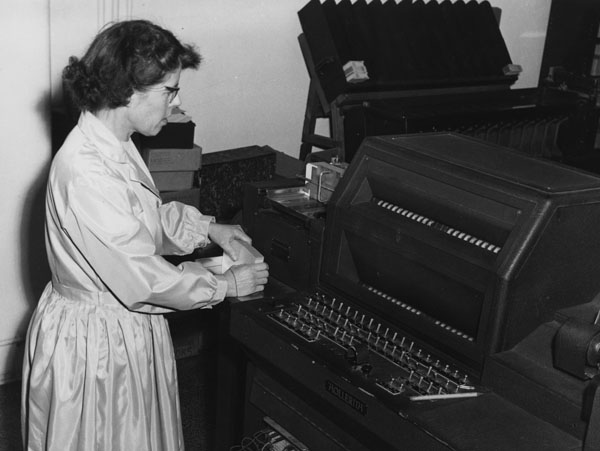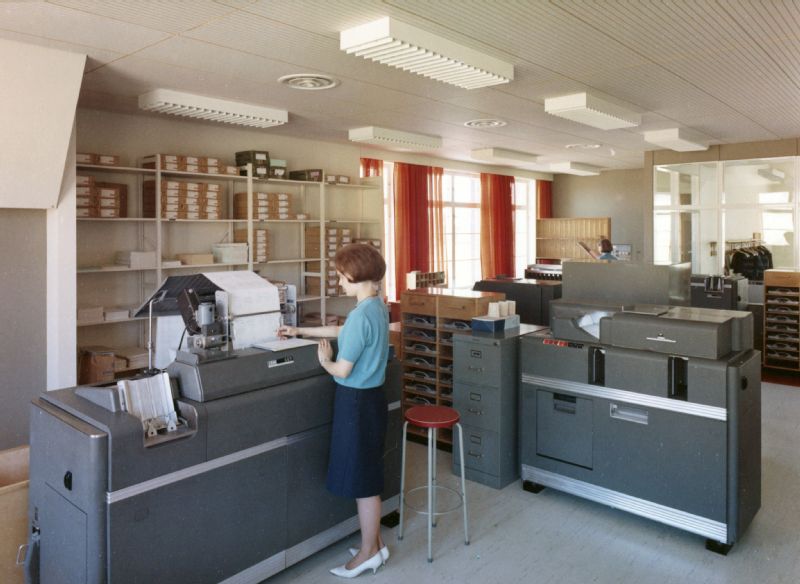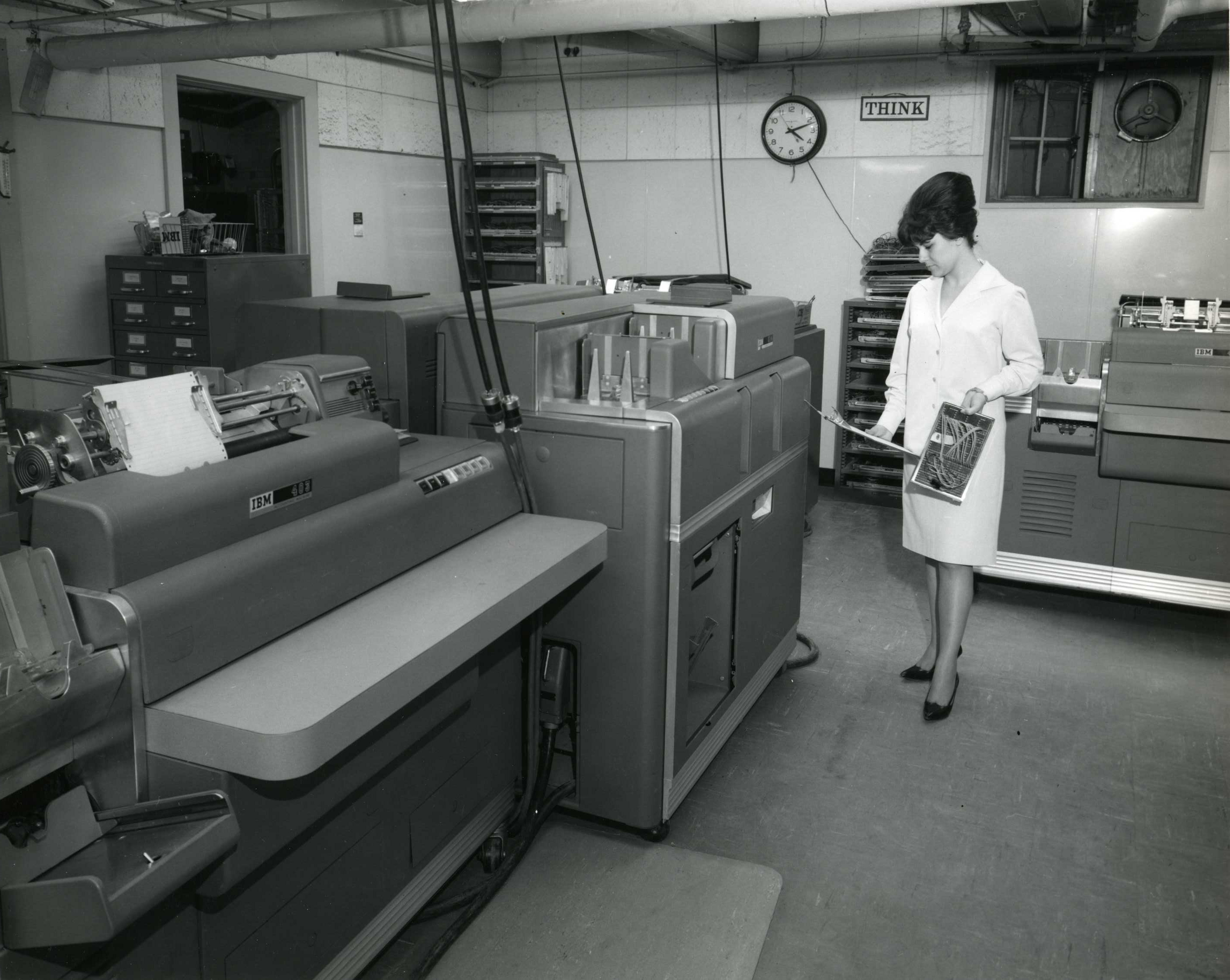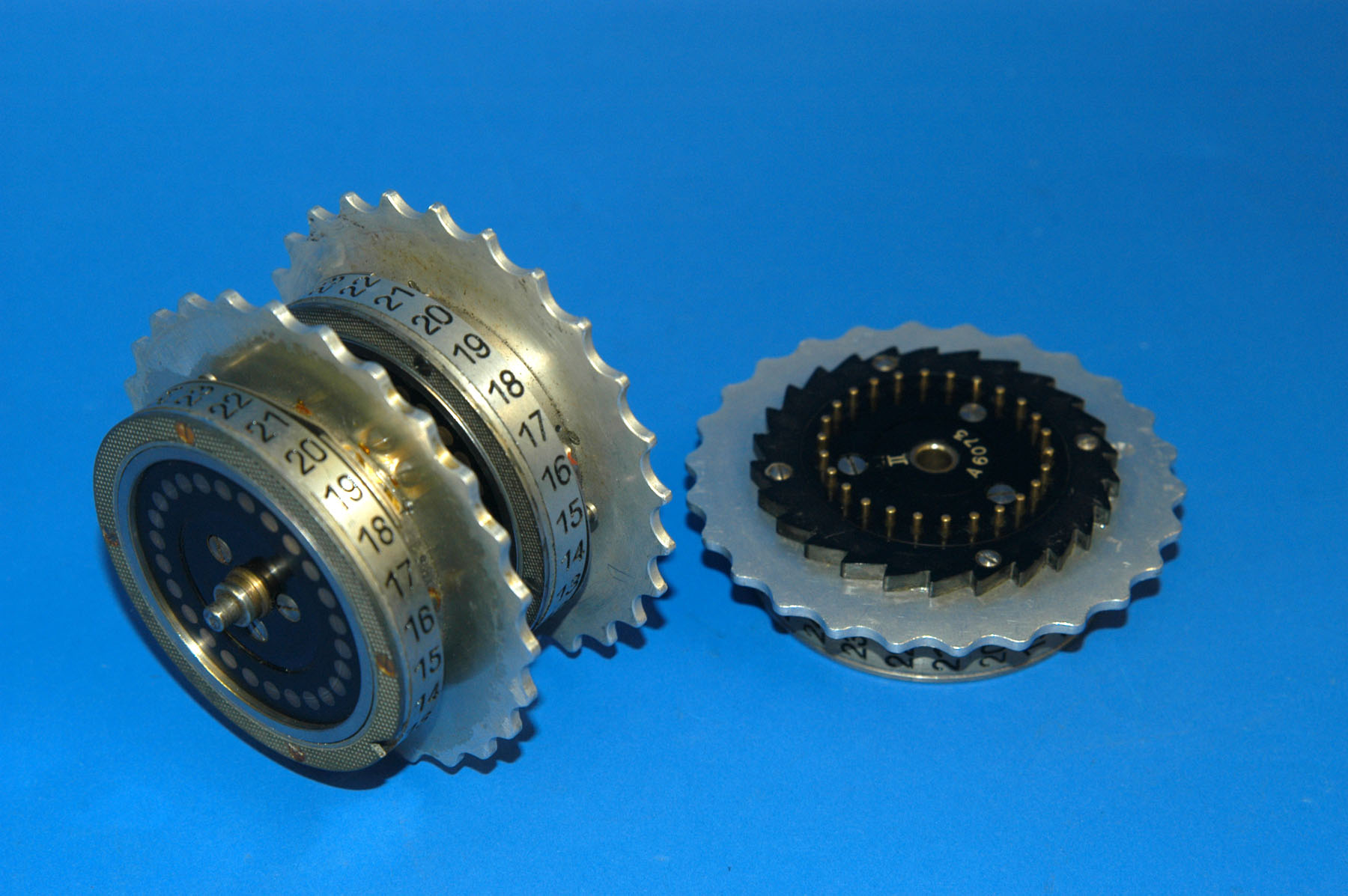|
Plugboard
A plugboard or control panel (the term used depends on the application area) is an array of jacks or sockets (often called hubs) into which patch cords can be inserted to complete an electrical circuit. Control panels are sometimes used to direct the operation of unit record equipment, cipher machines, and early computers. Unit record equipment Main article: Unit record equipment The earliest machines were hardwired for specific applications. Control panels were introduced in 1906 for the Hollerith Type 1 Tabulatorphoto of Type 3 with built-in control panel here. Removable control panels were introduced with the Hollerith ( IBM) type 3-S tabulator in the 1920s. Applications then could be wired on separate control panels, and inserted into tabulators as needed. Removable control panels came to be used in all unit record machines where the machines use for different applications required rewiring. IBM removable control panels ranged in size from 6 1/4" by 10 3/4" (for ma ... [...More Info...] [...Related Items...] OR: [Wikipedia] [Google] [Baidu] |
Cryptanalysis Of The Enigma
Cryptanalysis of the Enigma ciphering system enabled the western Allies in World War II to read substantial amounts of Morse-coded radio communications of the Axis powers that had been enciphered using Enigma machines. This yielded military intelligence which, along with that from other decrypted Axis radio and teleprinter transmissions, was given the codename '' Ultra''. The Enigma machines were a family of portable cipher machines with rotor scramblers. Good operating procedures, properly enforced, would have made the plugboard Enigma machine unbreakable. However, most of the German military forces, secret services, and civilian agencies that used Enigma employed poor operating procedures, and it was these poor procedures that allowed the Enigma machines to be reverse-engineered and the ciphers to be read. The German plugboard-equipped Enigma became Nazi Germany's principal crypto-system. In December 1932 it was "broken" by mathematician Marian Rejewski at the Polish G ... [...More Info...] [...Related Items...] OR: [Wikipedia] [Google] [Baidu] |
IBM 604
The IBM 604 Electronic Calculating Punch was the world's first mass-produced electronic calculator along with its predecessor the IBM 603.IBM 603 The First Commercial Electronic Calculator IBM History, accessed September 21, 2020] It was an electronic unit record equipment, unit record machine that could perform multiple calculations, including division. It was invented and developed by Ralph Palmer, Jerrier Haddad and Byron Phelps. It was introduced by IBM i ... [...More Info...] [...Related Items...] OR: [Wikipedia] [Google] [Baidu] |
Unit Record Equipment
Starting at the end of the nineteenth century, well before the advent of electronic computers, data processing was performed using electromechanical machines collectively referred to as unit record equipment, electric accounting machines (EAM) or tabulating machines. Unit record machines came to be as ubiquitous in industry and government in the first two-thirds of the twentieth century as computers became in the last third. They allowed large volume, sophisticated data-processing tasks to be accomplished before electronic computers were invented and while they were still in their infancy. This data processing was accomplished by processing punched cards through various unit record machines in a carefully choreographed progression. This progression, or flow, from machine to machine was often planned and documented with detailed flowcharts that used standardized symbols for documents and the various machine functions. All but the earliest machines had high-speed mechanical feeders ... [...More Info...] [...Related Items...] OR: [Wikipedia] [Google] [Baidu] |
Unit Record Equipment
Starting at the end of the nineteenth century, well before the advent of electronic computers, data processing was performed using electromechanical machines collectively referred to as unit record equipment, electric accounting machines (EAM) or tabulating machines. Unit record machines came to be as ubiquitous in industry and government in the first two-thirds of the twentieth century as computers became in the last third. They allowed large volume, sophisticated data-processing tasks to be accomplished before electronic computers were invented and while they were still in their infancy. This data processing was accomplished by processing punched cards through various unit record machines in a carefully choreographed progression. This progression, or flow, from machine to machine was often planned and documented with detailed flowcharts that used standardized symbols for documents and the various machine functions. All but the earliest machines had high-speed mechanical feeders ... [...More Info...] [...Related Items...] OR: [Wikipedia] [Google] [Baidu] |
History Of Computing Hardware
The history of computing hardware covers the developments from early simple devices to aid calculation to modern day computers. Before the 20th century, most calculations were done by humans. The first aids to computation were purely mechanical devices which required the operator to set up the initial values of an elementary arithmetic operation, then manipulate the device to obtain the result. Later, computers represented numbers in a continuous form (e.g. distance along a scale, rotation of a shaft, or a voltage). Numbers could also be represented in the form of digits, automatically manipulated by a mechanism. Although this approach generally required more complex mechanisms, it greatly increased the precision of results. The development of transistor technology and then the integrated circuit chip led to a series of breakthroughs, starting with transistor computers and then integrated circuit computers, causing digital computers to largely replace analog computers. Meta ... [...More Info...] [...Related Items...] OR: [Wikipedia] [Google] [Baidu] |
IBM 407
The IBM 407 Accounting Machine, introduced in 1949, was one of a long line of IBM tabulating machines dating back to the days of Herman Hollerith. It had a card reader and printer; a summary punch could be attached. Processing was directed by a control panel. The 407 was the central component of many unit record equipment shops which were the mainstay of IBM's business at the time. It could print digits, letters and several special characters in any of 120 print positions, spaced . In 1976 the IBM 407 Accounting Machine was withdrawn from marketing. Description The 407 read punched cards, totaled fields on the cards, made simple decisions, printed results, and, with the aid of a summary punch, output results on punched cards that could be input to other processing steps. The operation of the 407 was directed by the use of a removable control panel and a carriage tape. Exit hubs (impulse emitting) on the control panel are wired to entry hubs (impulse accepting) for the ... [...More Info...] [...Related Items...] OR: [Wikipedia] [Google] [Baidu] |
IBM 514
The IBM 519 Document-Originating Machine, introduced in 1946, was the last in a series of unit record machines designed for automated preparation of punched cards. Others in the series included the IBM 513 & IBM 514 Reproducing Punch. The 519, which was "state of the art for the time", could: * reproduce all or parts of the information on a set of cards * " gangpunch" - copy information from a master card into the following detail cards * print up to eight digits on the end of a card * compare two decks of cards * "summary punch" — create punch cards containing summary information provided by a connected accounting machine, such as totals from a group of processed cards * "mark sense" — detect marks made with an electrographic pencil in designated locations on a punched card and then punch holes corresponding to those marks into the card * number cards consecutively (an optional feature) The reproducing, gangpunching, summary punching, and comparing features of the IBM 519 are ... [...More Info...] [...Related Items...] OR: [Wikipedia] [Google] [Baidu] |
Tabulating Machine
The tabulating machine was an electromechanical machine designed to assist in summarizing information stored on punched cards. Invented by Herman Hollerith, the machine was developed to help process data for the 1890 U.S. Census. Later models were widely used for business applications such as accounting and inventory control. It spawned a class of machines, known as unit record equipment, and the data processing industry. The term " Super Computing" was used by the ''New York World'' newspaper in 1931 to refer to a large custom-built tabulator that IBM made for Columbia University. 1890 census The 1880 census had taken eight years to process. Since the U.S. Constitution mandates a census every ten years to apportion both congressional representatives and direct taxes among the states, a combination of larger staff and faster-recording systems was required. In the late 1880s Herman Hollerith, inspired by conductors using holes punched in different positions on a r ... [...More Info...] [...Related Items...] OR: [Wikipedia] [Google] [Baidu] |
Eniac Aberdeen
ENIAC (; Electronic Numerical Integrator and Computer) was the first programmable, electronic, general-purpose digital computer, completed in 1945. There were other computers that had these features, but the ENIAC had all of them in one package. It was Turing-complete and able to solve "a large class of numerical problems" through reprogramming. Although ENIAC was designed and primarily used to calculate artillery firing tables for the United States Army's Ballistic Research Laboratory (which later became a part of the Army Research Laboratory), its first program was a study of the feasibility of the thermonuclear weapon. ENIAC was completed in 1945 and first put to work for practical purposes on December 10, 1945.* ENIAC was formally dedicated at the University of Pennsylvania on February 15, 1946, having cost $487,000 (), and was heralded as a "Giant Brain" by the press. It had a speed on the order of one thousand times faster than that of electro-mechanical machines; thi ... [...More Info...] [...Related Items...] OR: [Wikipedia] [Google] [Baidu] |
Herman Hollerith
Herman Hollerith (February 29, 1860 – November 17, 1929) was a German-American statistician, inventor, and businessman who developed an electromechanical tabulating machine for punched cards to assist in summarizing information and, later, in accounting. His invention of the punched card tabulating machine, patented in 1884, marks the beginning of the era of mechanized binary code and semiautomatic data processing systems, and his concept dominated that landscape for nearly a century. Hollerith founded a company that was amalgamated in 1911 with several other companies to form the Computing-Tabulating-Recording Company. In 1924, the company was renamed "International Business Machines" ( IBM) and became one of the largest and most successful companies of the 20th century. Hollerith is regarded as one of the seminal figures in the development of data processing. Personal life Herman Hollerith was the son of German immigrant Georg Hollerith, a school teacher from Großfisch ... [...More Info...] [...Related Items...] OR: [Wikipedia] [Google] [Baidu] |
IBM 550
The IBM 550 numerical interpreter was the first commercial machine made by IBM that read numerical data punched on cards and printed it across the top of each card. The 550 was introduced in 1930. Information to be printed could be placed in any sequence via plugboard control panel selections. The machine operated at the rate of 75 cards a minute. The feed hopper had a capacity of 800 cards, and the stacker had a capacity of 1,000 cards. Alphabetic and numeric characters could be printed by the Type 552 alphabetic interpreter, announced in 1937. It could process 60 cards per minute. The Type 552 was withdrawn in December 1957. References *http://www.columbia.edu/acis/history/interpreter.html See also * Unit record equipment * IBM 557 Alphabetic Interpreter 550 550 __NOTOC__ Year 550 ( DL) was a common year starting on Saturday (link will display the full calendar) of the Julian calendar. The denomination 550 for this year has been used since the early medieval peri ... [...More Info...] [...Related Items...] OR: [Wikipedia] [Google] [Baidu] |
Rotor Machine
In cryptography, a rotor machine is an electro-mechanical stream cipher device used for encrypting and decrypting messages. Rotor machines were the cryptographic state-of-the-art for much of the 20th century; they were in widespread use in the 1920s–1970s. The most famous example is the German Enigma machine, the output of which was deciphered by the Allies during World War II, producing intelligence code-named ''Ultra''. Description The primary component of a rotor machine is a set of ''rotors'', also termed ''wheels'' or ''drums'', which are rotating disks with an array of electrical contacts on either side. The wiring between the contacts implements a fixed substitution of letters, replacing them in some complex fashion. On its own, this would offer little security; however, before or after encrypting each letter, the rotors advance positions, changing the substitution. By this means, a rotor machine produces a complex polyalphabetic substitution cipher, which changes ... [...More Info...] [...Related Items...] OR: [Wikipedia] [Google] [Baidu] |


.jpg)







